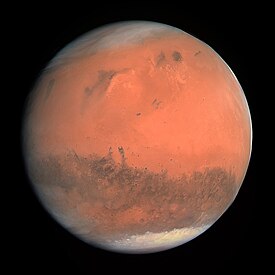Mars (planet)

Mars in natural colour in 2007
|
|||||||||||||||||
| Designations | |||||||||||||||||
|---|---|---|---|---|---|---|---|---|---|---|---|---|---|---|---|---|---|
| Pronunciation |
UK English: /mɑːz/ US English: |
||||||||||||||||
| Adjectives | Martian | ||||||||||||||||
| Orbital characteristics | |||||||||||||||||
| Epoch J2000 | |||||||||||||||||
| Aphelion |
1.6660 AU 249.2 Gm |
||||||||||||||||
| Perihelion |
1.3814 AU 206.7 Gm |
||||||||||||||||
|
1.523679 AU 227.9392 Gm |
|||||||||||||||||
| Eccentricity | 0.0934 | ||||||||||||||||
|
1.8808 Julian years 686.971 d 668.5991 sols |
|||||||||||||||||
| 779.96 days 2.135 Julian years |
|||||||||||||||||
|
Average orbital speed
|
24.077 km/s | ||||||||||||||||
| 19.373° | |||||||||||||||||
| Inclination | 1.850° to ecliptic 5.65° to Sun's equator 1.67° to invariable plane |
||||||||||||||||
| 49.558° | |||||||||||||||||
| 286.502° | |||||||||||||||||
| Satellites | 2 | ||||||||||||||||
| Physical characteristics | |||||||||||||||||
|
Mean radius
|
3,389.5±0.2 km | ||||||||||||||||
|
Equatorial radius
|
3,396.2±0.1 km |
||||||||||||||||
|
Polar radius
|
3,376.2±0.1 km |
||||||||||||||||
| Flattening | 0.00589±0.00015 | ||||||||||||||||
|
144,798,500 km2 |
|||||||||||||||||
| Volume |
1.6318×1011 km3 |
||||||||||||||||
| Mass |
6.4171×1023 kg |
||||||||||||||||
|
Mean density
|
3.9335±0.0004 g/cm³ | ||||||||||||||||
|
3.711 m/s² |
|||||||||||||||||
| 0.3662±0.0017 | |||||||||||||||||
| 5.027 km/s | |||||||||||||||||
|
Sidereal rotation period
|
1.025957 d |
||||||||||||||||
|
Equatorial rotation velocity
|
868.22 km/h (241.17 m/s) | ||||||||||||||||
| 25.19° to its orbital plane | |||||||||||||||||
|
North pole right ascension
|
21h 10m 44s |
||||||||||||||||
|
North pole declination
|
52.88650° | ||||||||||||||||
| Albedo | 0.170 (geometric) 0.25 (Bond) |
||||||||||||||||
|
|||||||||||||||||
| +1.6 to −3.0 | |||||||||||||||||
| 3.5–25.1″ | |||||||||||||||||
| Atmosphere | |||||||||||||||||
|
Surface pressure
|
0.636 (0.4–0.87) kPa 0.00628 atm |
||||||||||||||||
| Composition by volume |
|
||||||||||||||||
3,396.2±0.1 km
3,376.2±0.1 km
144,798,500 km2
1.6318×1011 km3
6.4171×1023 kg
3.711 m/s²
1.025957 d
21h 10m 44s
Mars is the fourth planet from the Sun and the second-smallest planet in the Solar System, after Mercury. Named after the Roman god of war, it is often referred to as the "Red Planet" because the iron oxide prevalent on its surface gives it a reddish appearance. Mars is a terrestrial planet with a thin atmosphere, having surface features reminiscent both of the impact craters of the Moon and the valleys, deserts, and polar ice caps of Earth.
The rotational period and seasonal cycles of Mars are likewise similar to those of Earth, as is the tilt that produces the seasons. Mars is the site of Olympus Mons, the largest volcano and second-highest known mountain in the Solar System, and of Valles Marineris, one of the largest canyons in the Solar System. The smooth Borealis basin in the northern hemisphere covers 40% of the planet and may be a giant impact feature. Mars has two moons, Phobos and Deimos, which are small and irregularly shaped. These may be captured asteroids, similar to 5261 Eureka, a Mars trojan.
...
Wikipedia
